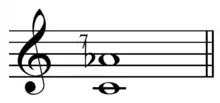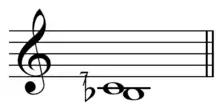Subminor and supermajor
In music, a subminor interval is an interval that is noticeably wider than a diminished interval but noticeably narrower than a minor interval. It is found in between a minor and diminished interval, thus making it below, or subminor to, the minor interval. A supermajor interval is a musical interval that is noticeably wider than a major interval but noticeably narrower than an augmented interval. It is found in between a major and augmented interval, thus making it above, or supermajor to, the major interval. The inversion of a supermajor interval is a subminor interval, and there are four major and four minor intervals, allowing for eight supermajor and subminor intervals, each with variants.
| diminished | subminor | minor | major | supermajor | augmented | |
|---|---|---|---|---|---|---|
| seconds | D |
≊ D |
D♭ | D | ≊ D |
D♯ |
| thirds | E |
≊ E |
E♭ | E | ≊ E |
E♯ |
| sixths | A |
≊ A |
A♭ | A | ≊ A |
A♯ |
| sevenths | B |
≊ B |
B♭ | B | ≊ B |
B♯ |

Traditionally, "supermajor and superminor, [are] the names given to certain thirds [9:7 and 17:14] found in the justly intoned scale with a natural or subminor seventh."[2]
Subminor second and supermajor seventh
Thus, a subminor second is intermediate between a minor second and a diminished second (enharmonic to unison). An example of such an interval is the ratio 26:25, or 67.90 cents (D![]()
![]() -
- ![]() Play ). Another example is the ratio 28:27, or 62.96 cents (C
Play ). Another example is the ratio 28:27, or 62.96 cents (C![]() ♯-
♯- ![]() Play ).
Play ).
A supermajor seventh is an interval intermediate between a major seventh and an augmented seventh. It is the inverse of a subminor second. Examples of such an interval is the ratio 25:13, or 1132.10 cents (B![]() ♯); the ratio 27:14, or 1137.04 cents (B
♯); the ratio 27:14, or 1137.04 cents (B![]()
![]() Play ); and 35:18, or 1151.23 cents (C
Play ); and 35:18, or 1151.23 cents (C![]()
![]() Play ).
Play ).
Subminor third and supermajor sixth

A subminor third is in between a minor third and a diminished third. An example of such an interval is the ratio 7:6 (E![]() ♭), or 266.87 cents,[3][4] the septimal minor third, the inverse of the supermajor sixth. Another example is the ratio 13:11, or 289.21 cents (E
♭), or 266.87 cents,[3][4] the septimal minor third, the inverse of the supermajor sixth. Another example is the ratio 13:11, or 289.21 cents (E![]() ↓♭).
↓♭).
A supermajor sixth is noticeably wider than a major sixth but noticeably narrower than an augmented sixth, and may be a just interval of 12:7 (A![]() ).[5][6][7] In 24 equal temperament A
).[5][6][7] In 24 equal temperament A![]() = B
= B![]() . The septimal major sixth is an interval of 12:7 ratio (A
. The septimal major sixth is an interval of 12:7 ratio (A![]()
![]() Play ),[8][9] or about 933 cents.[10] It is the inversion of the 7:6 subminor third.
Play ),[8][9] or about 933 cents.[10] It is the inversion of the 7:6 subminor third.
Subminor sixth and supermajor third
A subminor sixth or septimal sixth is noticeably narrower than a minor sixth but noticeably wider than a diminished sixth, enharmonically equivalent to the major fifth. The sub-minor sixth is an interval of a 14:9 ratio[6][7] (A![]() ♭) or alternately 11:7.[5] (G↑-
♭) or alternately 11:7.[5] (G↑- ![]() Play ) The 21st subharmonic (see subharmonic) is 729.22 cents.
Play ) The 21st subharmonic (see subharmonic) is 729.22 cents. ![]() Play
Play

A supermajor third is in between a major third and an augmented third, enharmonically equivalent to the minor fourth. An example of such an interval is the ratio 9:7, or 435.08 cents, the septimal major third (E![]() ). Another example is the ratio 50:39, or 430.14 cents (E
). Another example is the ratio 50:39, or 430.14 cents (E![]() ♯).
♯).
Subminor seventh and supermajor second
A subminor seventh is an interval between a minor seventh and a diminished seventh. An example of such an interval is the 7:4 ratio, the harmonic seventh (B![]() ♭).
♭).
A supermajor second (or supersecond[2]) is intermediate to a major second and an augmented second. An example of such an interval is the ratio 8:7, or 231.17 cents,[1] also known as the septimal whole tone (D![]() -
- ![]() Play ) and the inverse of the subminor seventh. Another example is the ratio 15:13, or 247.74 cents (D
Play ) and the inverse of the subminor seventh. Another example is the ratio 15:13, or 247.74 cents (D![]() ♯).
♯).
Use
Composer Lou Harrison was fascinated with the 7:6 subminor third and 8:7 supermajor second, using them in pieces such as Concerto for Piano with Javanese Gamelan, Cinna for tack-piano, and Strict Songs (for voices and orchestra).[12] Together the two produce the 4:3 just perfect fourth.[13]
19 equal temperament has several intervals which are simultaneously subminor, supermajor, augmented, and diminished, due to tempering and enharmonic equivalence (both of which work differently in 19-ET than standard tuning). For example, four steps of 19-ET (an interval of roughly 253 cents) is all of the following: subminor third, supermajor second, augmented second, and diminished third.
Sources
- Leta E. Miller, ed. (1988). Lou Harrison: Selected keyboard and chamber music, 1937-1994, p.xliii. ISBN 978-0-89579-414-7.
- Brabner, John H. F. (1884). The National Encyclopaedia, Vol.13, p.182. London. [ISBN unspecified]
- Von Helmholtz, Hermann L. F (2007). On the Sensations of Tone, p.195&212. ISBN 978-1-60206-639-7.
- Miller (1988), p.xlii.
- Andrew Horner, Lydia Ayres (2002). Cooking with Csound: Woodwind and Brass Recipes, p.131. ISBN 0-89579-507-8.
- Royal Society (Great Britain) (1880, digitized Feb 26, 2008). Proceedings of the Royal Society of London, Volume 30, p.531. Harvard University.
- Society of Arts (Great Britain) (1877, digitized Nov 19, 2009). Journal of the Society of Arts, Volume 25, p.670. The Society.
- Partch, Harry (1979). Genesis of a Music, p.68. ISBN 0-306-80106-X.
- Haluska, Jan (2003). The Mathematical Theory of Tone Systems, p.xxiii. ISBN 0-8247-4714-3.
- Hermann L. F Von Helmholtz (2007). On the Sensations of Tone, p.456. ISBN 978-1-60206-639-7.
- John Fonville. "Ben Johnston's Extended Just Intonation- A Guide for Interpreters", p.122, Perspectives of New Music, Vol. 29, No. 2 (Summer, 1991), pp. 106–137.
- Miller and Lieberman (2006), p.72.
- Miller & Lieberman (2006), p.74. "The subminor third and supermajor second combine to create a pure fourth (8⁄7 x 7⁄6 = 4⁄3)."




